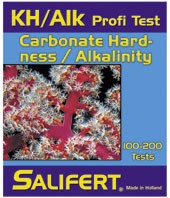Salifert
Salifert KH - Professional Test for Seawater
Salifert KH - Professional Test for Seawater
Couldn't load pickup availability
Calcium alone cannot form the skeletal material of corals and enable the growth of calcareous algae. Other substances are needed. Some additional components are carbonate and bicarbonate. These two substances also have a major influence on stabilizing the pH value in the optimal range of 8.1 to 8.4. Such stabilization is also called buffering. The total concentration of carbonate and bicarbonate is also called carbonate alkalinity or carbonate hardness. The only difference between alkalinity and carbonate hardness is a conversion factor. Natural seawater (NSW) has an alkalinity of approximately 2.7 meq/L, or approximately 7.5 dKH, when expressed as carbonate hardness. For a stable system, the alkalinity or carbonate hardness should be similar to or slightly higher than NSW and preferably not fluctuate by more than 5%. This means a maximum fluctuation of 0.14 meq/L, or 0.4 dKH. Therefore, an alkalinity test kit should be able to measure in increments smaller than 0.14 meq/L.
Conclusion: Since bicarbonate and carbonate are the most important buffering components for coral and coralline algae growth, they should be added to correct a drop in alkalinity or carbonate hardness. A properly formulated buffer product should function in such a way that the corrective measures have a long-lasting effect and do not affect the pH of the system. Alkalinity or carbonate hardness should be kept as stable as possible, which requires highly sensitive and precise testing methods.
The Salifert KH/Alk test is very easy to use. It measures in sufficiently small increments of 0.1 meq/L or 0.3 dKH with a clear color change. This allows for the detection of important, yet small, changes. The kit can perform approximately 100 to 200 measurements.
The Salifert KH + pH Buffer makes correcting alkalinity or carbonate hardness easy and doesn't disturb the system's pH. Within 24 hours, the pH will adjust to match the other aquarium parameters. If the pH remains low within 24 hours of corrective measures, insufficient gas exchange (inefficient aeration) is often the cause.
Share


